Legio XXII Primigenia
Legio XXII Primigenia: one of the Roman legions. The surname Primigenia is one of the titles of the goddess Fortuna.
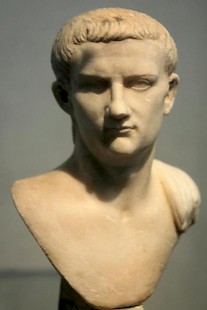
This legion (and its twin XV Primigenia) was founded by the emperor Caligula in 39, who needed extra forces for his campaigns in Germania. The numbers are perhaps a bit odd. Why fifteen and twenty-two? A possible explanation is that XV Primigenia was to support the Fourteenth legion Gemina in Germania Superior, and that XXII Primigenia was to support XXI Rapax at Xanten in Germania Inferior. Some sort of confirmation of this hypothesis is to be found in the fact that Caligula was indeed interested in Germania Inferior. He visited the Lower Rhine area in 40, where he fortified several towns (e.g., Praetorium Agrippinae, Flevum, Fectio) and visited the beach of Lugdunum with many soldiers. What happened next, is told by his biographer Suetonius:
Finally, as if resolved to make war in earnest, he drew up a line of battle on the shore of the ocean, placed his ballistas and other artillery, and, no one knowing or able to imagine what he was going to do, he all of a sudden commanded they gather sea shells and fill their helmets and pockets with them [...]. As a monument of this victory, he erected a lofty tower, from which lights were to shine at night to guide the course of ships, as from the lighthouse of Alexandria.note
After the emperor had returned to Rome, there was a lot of fighting in the Rhineland. The governor of Germania Inferior, Aulus Gabinius Secundus, overcame the Chauci and recovered one of the eagle standards that had remained in the hands of the enemies after the battle in the Teutoburg Forest. At the same time, Servius Sulpicius Galba (the future emperor) overcame the Chatti, who lived near Mainz. XXII Primigenia must have been involved in one of or even both campaigns, which are dated to the winter of 40/41.
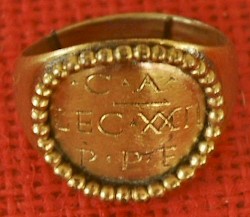
However, the soldiers (almost all Italians) had already seen their first action before, in the neighborhood of Wiesbaden, in 39. According to our sources, Caligula's campaigns on the east bank of the Rhine were not really important, but archaeological finds suggest that this is not true.
On returning from the Lower Rhine area (assuming that the new legion did indeed make the trip to the north) in 43, the Twenty-second was stationed at Mainz in Germania Superior, where it was to share the fortress with IIII Macedonica, which arrived from Hispania. As XXII Primigenia was the younger unit, it occupied the less honorable left-hand side in the fortress, whereas the Fourth was living on the right-hand side. The two legions also shared a production center for tiles and pottery at Rheinzabern in the Palatinate.
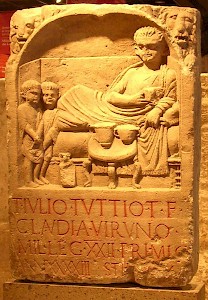
In 67, the position of the emperor Nero became untenable. Many senators were discontent and several governors discussed his removal. Among these were Lucius Clodius Macer of Africa (who recruited the I Macriana Liberatrix) and Gaius Julius Vindex of one of the provinces in Gaul. They supported the governor of Hispania Tarraconensis, the above-mentioned Servius Sulpicius Galba, when he proclaimed that he wanted to dethrone Nero.
This was treason, and the army of Germania Inferior (I Germanica, V Alaudae, XV Primigenia and XVI Gallica) knew what they had to do: they marched to the south and defeated Vindex. They expected to be rewarded, but were disappointed: Galba and a newly recruited Seventh Legion marched on Rome, the Senate recognized him, and Nero committed suicide (June 68). What had been exemplary behavior, was now explained as an attempt to obstruct the accession of the new emperor, who did not do much to take away the impression that he despised the Rhine army.
Therefore, the armies of Germania Inferior and Superior acclaimed their own commander, Vitellius, as emperor, and marched on Rome (January 69). They were successful, and Vitellius started his reign. A subunit, consisting of soldiers of XXII Primigenia and IIII Macedonica, took part in this campaign, and the eagle standard of the Twenty-second was shown when Vitellius entered the capital.
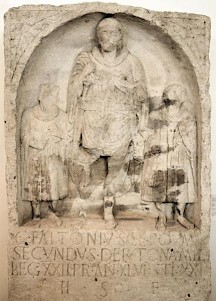
However, in Judaea, general Vespasian, who was fighting against the Jews, had also decided to make a bid for power. He was supported by the army of the Danube. The two armies clashed near Cremona in northern Italy, and the soldiers of the Rhine army turned out to be no match for those of the Danube army. Vespasian could start to reign and heal the wounds of the civil war of 69, the "year of the four emperors".
Meanwhile, in Germania Inferior, a disaster was in the making. The Batavians felt offended because (among other reasons) Galba had dismissed his Batavian bodyguard, and revolted. A Roman expeditionary force, consisting of the remains of V Alaudae and XV Primigenia, was defeated near Nijmegen, and in the winter of 69/70, these two units found themselves besieged at Xanten.
XXII Primigenia, which was commanded by Gaius Dillius Vocula, was sent out to rescue them, together with I Germanica and XVI Gallica. However, they were unable to defend both Germania Inferior and Superior, and the two legions at Xanten were forced to surrender in March 70. They were massacred. Not much later, I Germanica and XVI Gallica surrendered as well. The Twenty-second, on the other hand, remained steadfast and defended Mainz, which was eventually captured too.
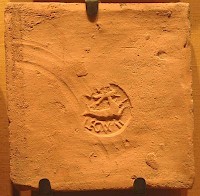
It took several months before the new emperor Vespasian could send a strong Roman army to recover the Rhineland, commanded by his relative Quintus Petillius Cerialis. After the civil war and the end of the Batavian revolt (in the autumn of 70), the legion was briefly sent to Vindobona (Vienna), but was finally settled at Xanten. The soldiers did not stay at the old fortress, which had been destroyed by the Batavians, but they built a new base. This cannot be excavated because the Rhine has changed its course and has destroyed the castle. However, sometimes, ancient objects are found in the river. The presence of a large cemetery and a sanctuary of Hludana are ascertained. The products of the legion's nearby kilns have been found in Cologne, Dormagen, Neuss, the civil town of Xanten, Rindern, Nijmegen, and Vechten.
When in 89 the governor of Germania Superior, Lucius Antonius Saturninus, tried to overthrow the emperor Domitian, the army of Germania Inferior (I Minervia, VI Victrix, X Gemina, XXII Primigenia) hurried to the south, to Mainz, and defeated the rebel. Every legion was awarded the title Pia Fidelis Domitiana ("faithful and loyal to Domitian"). When this emperor was killed in 96, the last element of this honorific title was dropped.
At that moment, XXII Primigenia had returned to Mainz, where it was to stay for more than two centuries. Among its officers were the future emperors Hadrian, Didius Julianus and Laelianus (97-98, 170-171 and 268-269; below). Subunits were sometimes sent to other provinces. For example, when I Minervia, normally staying in Bonn, had moved to the Lower Danube to take part in Trajan's Dacian war (101-106), soldiers of the Twenty-second garrisoned Bonn. Later, soldiers from Mainz helped constructing Hadrian's wall (119) and the Antonine wall (139-142). Other building activities took place on the east bank of the Rhine, where the Ager decumates (modern Baden-Württemberg) was occupied and many forts were constructed.
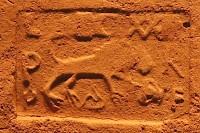
Other subunits took part in the war against the Mauri during the reign of Antoninus Pius, in the Parthian War of Lucius Verus, and Marcus Aurelius' wars against the Marcomanni. One of the officers serving in these years was Didius Julianus.
Like the other units of the Rhine army, XXII Primigenia took no part in the civil war after the death of the emperor Publius Helvius Pertinax. It was not present when Lucius Septimius Severus marched on Rome (193), fought against his eastern rival Pescennius Niger (194) or invaded Parthia. However, when Severus launched a war against his western rival Clodius Albinus, the Rhine army was under attack, and the Twenty-second defended Trier. Probably, it also played a role in the decisive battle at Lyon. A subunit may have joined Severus' later expedition to Scotland.
From the legion's surname Antoniniana, it can be deduced that soldiers of the twenty-second legion took part in Caracalla's successful Germanic campaign (213). As a preparation to this war, they rebuilt the Rhine bridge at Mainz. (Other units in this war were VIII Augusta from Strasbourg and III Italica from Regensburg.)
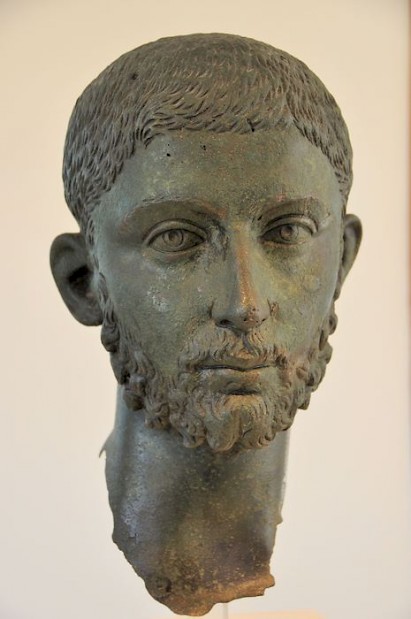
Twenty years later, the emperor Severus Alexander used subunits in his war against the Persian Sasanians. The legion was awarded with the title Alexandriana. While so many Roman soldiers were away, a coalition of Germanic warriors, the Alamanni, attacked the Roman possessions in Baden-Württemberg, where the caesar collapsed. In 235, the Roman retaliated and we must assume that XXII Primigenia was one of the active units.
However, the soldiers lynched Severus Alexander and his mother Julia Mamaea when they started negotiations with the Germanic tribesmen and wanted to buy them off. The new emperor, Maximinus Thrax, brought the war to a good end.
During the conflict between the emperor Gallienus (260-268) and his rival Postumus, the legion first supported the first-mentioned, for which it was rewarded with surnames like Pia VI Fidelis VI ("six times faithful and loyal") and Pia VII Fidelis VII. This proves that it had been awarded the titles Pia II Fidelis II to Pia V Fidelis V in the 164 years between Domitian and Gallienus, but we have no idea when this happened.
An inscription from Perinthus, on the northern shore of the Sea of Marmara, suggests that a subunit was active in one of Gallienus' campaigns against the Visigoths.
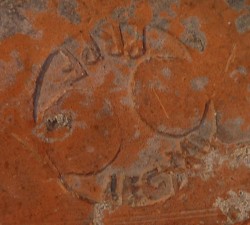
After the death of Gallienus, the Twenty-second and the city of Mainz were briefly independent under a man named Laelianus, the commander of the unit. Possibly, he added a new legion, VI Gallicana. In 269, Postumus subdued this city-state and added Mainz to the Gallic Empire, although he was killed when he tried to prevent his soldiers from sacking the town. The legion survived the crisis of 274, when the emperor Aurelian subdued the Gallic empire and unleashed an invasion of Franks and Alamanni. We know that XXII Primigenia still existed at the beginning of the fourth century, because it received the honorific title "Primigenia CV", which must mean Constantiana Victrix", but after the reign of Constantine I the Great (306-337), it disappears from our sources. It may have been destroyed during the Battle of Mursa in which Constantius II defeated his western rival Magnentius; the survivors may or may not have become the Twelfth Legion Victrix.
The emblems of the Twenty-second were the demigod Hercules and the Capricorn. Hercules was ignored in the third century. The Capricorn may have been chosen because it could be represented with the same symbols as the goddess Fortuna.
Several roof tiles show a lion with an amphora and something that resembles a snake. This may be a representation of a myth or a fable, not a military emblem.
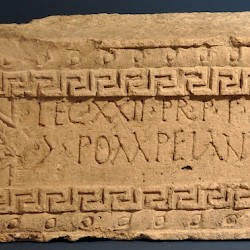 Mainz, Inscription of XXII Primigenia |
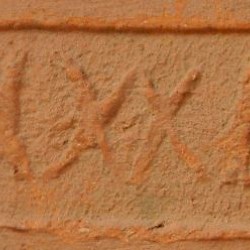 Xanten, Tile of XXII Primigenia |
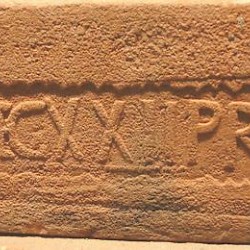 Tile of XXII Primigenia Pia Fidelis |
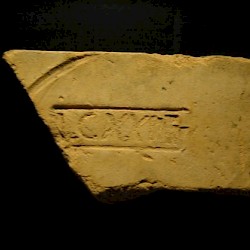 Stamp of XXII Primigenia |
Literature
- T. Franke, "Legio XXII Primigenia", in: Yann Le Bohec, Les légions de Rome sous le Haut-Empire (2000 Lyon) 95-104
- I. Piso, "Les légions dans la province de Dacie", in: Yann Le Bohec, Les légions de Rome sous le Haut-Empire (2000 Lyon) 205-225